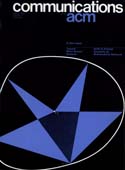August 1974 - Vol. 17 No. 8

Features
A new technique for compression and storage of data
The widespread tendency toward storage of large programs and blocks of text has produced a need for efficient methods of compressing and storing data. This paper describes techniques that can, in most cases, decrease storage size by a factor of from two to four. The techniques involve special handling of leading and trailing blanks, and the encoding of other symbols in groups of fixed size as unique fixed point numbers. The efficiency of the system is considered and pertinent statistics are given and compared with statistics for other information coding techniques.
A user authentication scheme not requiring secrecy in the computer
In many computer operating systems a user authenticates himself by entering a secret password known solely to himself and the system. The system compares this password with one recorded in a Password Table which is available to only the authentication program. The integrity of the system depends on keeping the table secret. In this paper a password scheme is presented which does not require secrecy in the computer. All aspects of the system, including all relevant code and data bases, may be known by anyone attempting to intrude.
The scheme is based on using a function H which the would-be intruder is unable to invert. This function is applied to the user's password and the result compared to a table entry, a match being interpreted as authentication of the user. The intruder may know all about H and have access to the table, but he can penetrate the system only if he can invert H to determine an input that produces a given output.
This paper discusses issues surrounding selection of a suitable H. Two different plausible arguments are given that penetration would be exceedingly difficult, and it is then argued that more rigorous results are unlikely. Finally, some human engineering problems relating to the scheme are discussed.
A high security log-in procedure
The protection of time sharing systems from unauthorized users is often achieved by the use of passwords. By using one-way ciphers to code the passwords, the risks involved with storing the passwords in the computer can be avoided. We discuss the selection of a suitable one-way cipher and suggest that for this purpose polynomials over a prime modulus are superior to one-way ciphers derived from Shannon codes.
Execution time requirements for encipherment programs
Although encipherment has often been discussed as a means to protect computer data, its costs are not well established. Five experiments were conducted to measure the cpu time on a CDC 6400 required by additive ciphers programmed both in assembly language and in Fortran: a “null transformation” to measure the time to move data without encipherment; encipherment with a one-word key; encipherment with a 125-word key; double key encipherment; and encipherment using a pseudo random key. The results were analyzed for consistency over 100 runs, and the effects of constant and intermittent errors were considered.
Timing rates for assembly language encipherment ranged from 498,800 characters per second for a pseudo random key cipher to 2,092,000 characters per second for a constant one-word key cipher. The latter is almost equivalent to the rate required simply to move data without encipherment. Fortran tests required over four times as much cpu time. This paper introduces the idea of enciphering time coefficient the ratio of enciphering time to the time taken to fetch and store data without encipherment.
Graph coloring conditions for the existence of solutions to the timetable problem
A necessary and sufficient condition is presented for the existence of a solution to the Gotlieb class-teacher timetable problem. Several relationships are established between the class-teacher timetable problem and graphs with preconditions. These preconditions place additional restrictions on the coloration of a graph. The preconditions correspond to the unavailability constraints and preassigned meetings in the class-teacher timetable problem. Using some recent results that convert graphs with preconditions to graphs without them, it is shown that the existence of a coloration of a graph is the required necessary and sufficient condition.
A new solution of Dijkstra’s concurrent programming problem
A simple solution to the mutual exclusion problem is presented which allows the system to continue to operate despite the failure of any individual component.
On the conversion of programs to decision tables: method and objectives
The problems of converting programs to decision tables are investigated. Objectives of these conversions are mainly program debugging and optimization in practice. Extensions to the theory of computation and computability are suggested.
Gauss harmonic interpolation formulas
Let R be an open, bounded, simply connected region in the (x,y)-plane and let (x*,y*) be a point in R. Assuming R is starlike with respect to (x*,y*), we discuss a method for computing Gauss harmonic interpolation formulas for R and the point (x*,y*). Such formulas approximate a harmonic function at (x*,y*) in terms of a linear combination of its values at certain selected points on the boundary of R. Such formulas are useful for approximating the solution of the Dirichlet problem for R.
Interpolation with rounded ramp functions
A new interpolation function is introduced. It has infinitely many continuous derivatives and is a composition of ramp functions with smoothed bends called Rounded Ramp Functions. How the interpolation function can be extended to more than one variable is shown. An efficient Fortran program is given by which the interpolation function can be obtained for a given point set.
Recurrence relations for the Fresnel integral 0∞exp -ctdtt 1+t2
The class of functions defined by ∫∞0[exp(-cX)dt/(1 + Y) (√t)k] where X and Y are either t or t2 and k is -1, 0, or 1 can be evaluated by recurrences for all but small values of the parameter c. These recurrences, given here, are more efficient than the usual asymptotic series.



